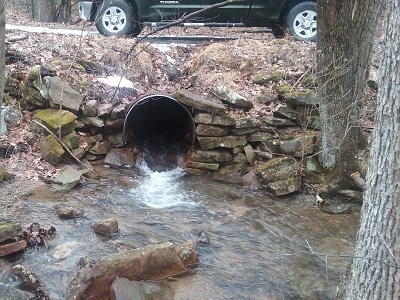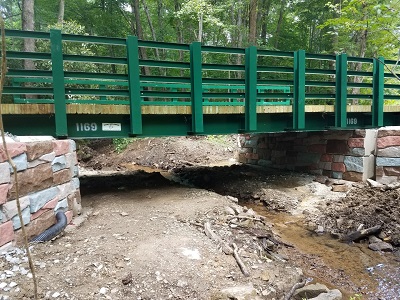Dams, undersized culverts and sedimentation are no friends to fish, hellbenders, mussels and other aquatic organisms. When stream-dwelling creatures can’t move upstream freely, “There’s very limited intermingling of genetics in that ecosystem,” says Western Pennsylvania Conservancy Watershed Manager Greg Schaetzle. “A limited genetic pool lends itself to genetic weaknesses and diseases.” Acid mine drainage, farmland runoff or sediment from a gravel road can also hinder an aquatic organism’s ability to move through sections of a stream.
Enter aquatic organism passage projects, which remove a barrier or improve infrastructure so those stream dwellers can move freely up and downstream. The Conservancy has seen improvements in streams it has monitored after installing AOPs, Greg says. For example, after replacing a culvert with a timber deck bridge on a wild brook trout stream within Laurel Hill State Park in 2019, there was a significant increase in brook trout numbers upstream.


AOP work improves stream inhabitants’ health and diversifies the population. “When we can remove the physical, chemical or thermal barrier, that vital, free migration can happen,” Greg says. “Isolated populations of aquatic species can intermingle,” allowing for genetic fitness that helps a watershed recolonize, increasing the long-term survival rate of a species.
The symbiosis between freshwater mussels and fish is a great example. The mussels can’t move, so they lay their eggs on passing fish, which transport the eggs to other areas. But if the fish can’t get past a barrier, the mussels won’t either.
But if fish can move downstream, mussels can populate elsewhere. Greg explains, “When aquatic organisms have a connected system and are free to access all areas—such as spawning grounds for fish, mussel beds or large rocks that hellbender salamanders live under—it’s beneficial for genetic diversity.”
###
About the Western Pennsylvania Conservancy:
The Western Pennsylvania Conservancy (WPC) enhances the region by protecting and restoring exceptional places. A private nonprofit conservation organization founded in 1932, WPC has helped establish 11 state parks, conserved more than a quarter million acres of natural lands, protected or restored more than 3,000 miles of rivers and streams, and assessed thousands of wildlife species and their habitats. The Conservancy owns and operates Frank Lloyd Wright’s Fallingwater, which is on the UNESCO World Heritage List and symbolizes people living in harmony with nature. In addition, WPC enriches our region’s cities and towns through 130 community gardens and other green spaces and thousands of trees that are planted with the help of more than 7,000 volunteers. The work of the Conservancy is accomplished through the support of more than 10,000 members. For more information, visit WaterLandLife.org or Fallingwater.org.
